Java中有双端队列(Deque)。Deque 接口是Java集合框架的一部分,它提供了双端队列的功能。双端队列允许元素从两端被插入和移除。Java提供了几种实现了Deque接口的类,其中最常用的是ArrayDeque和LinkedList。
java中栈的实现方式可以用List
Deque stack = new LinkedList();
stack.pop() stack.push() stack.isEmpty() stack.peek()
Queue是队列,
queue.poll() queue.offer() queue.isEmpty() queue.peek()
StringBulider
sb.delete(0,3), sb.insert(0,c), sb.append©
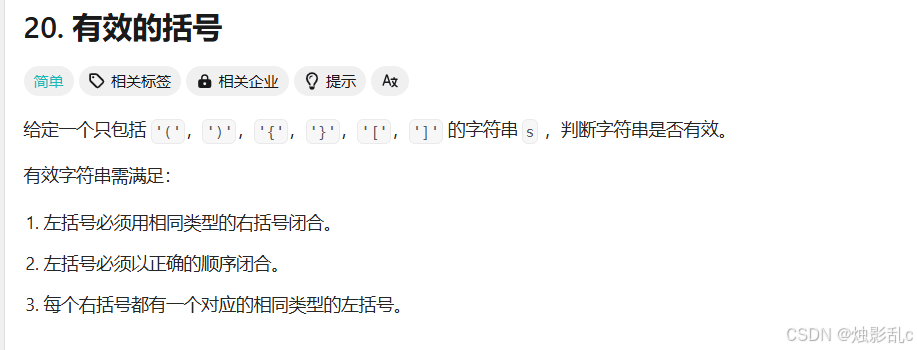
创建个Stack来储存右括号,遍历s时,每当遇见左括号就push一个相应的右括号。当遇见右括号时先判断stack是否为空,为空说明s中左括号少,false。如果stack不为空,说明左括号不少,再判断stack.pop的是不是该字符,不是则false(非正确顺序闭合)。遍历完之后,说明s中右括号都正确匹配到了左括号,消耗光了右括号,但不知道左括号还有没有剩余,此时再判断stack中是否为空,为空则左右正好,否则左多。(false情况:左少,左多,左右正好但非正确顺序)
Integer.parseInt(s)可以将字符串s解析为int。可以利用这个写出isNumber()函数。
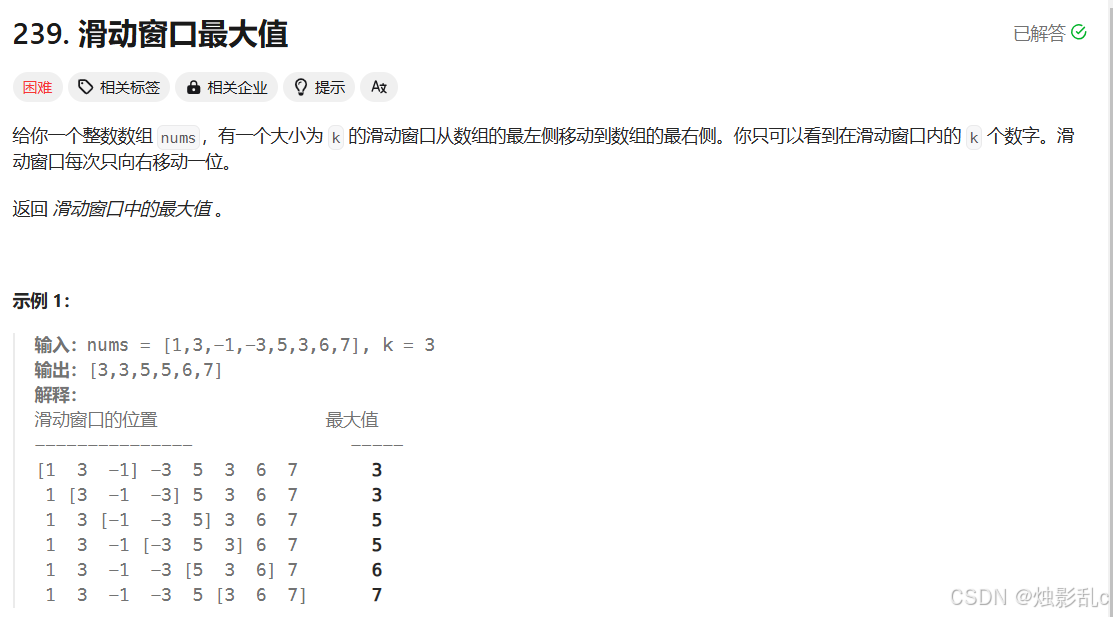
主要思想就是维护一个 单调双端队列。这个队列储存窗口最大值的下标。
单调性的保证:每次要offerLast前,先判断nums[i]和nums[deque.peekLast()]的大小,直至nums[deque.peekLast()]大于nums[i],再offerLast(i)
队列里只含窗口下标的保证:每次offerLast之后,循环比较deque.peekFirst()和窗口左端的下标值(i-k),直至最大值下标在窗口内。
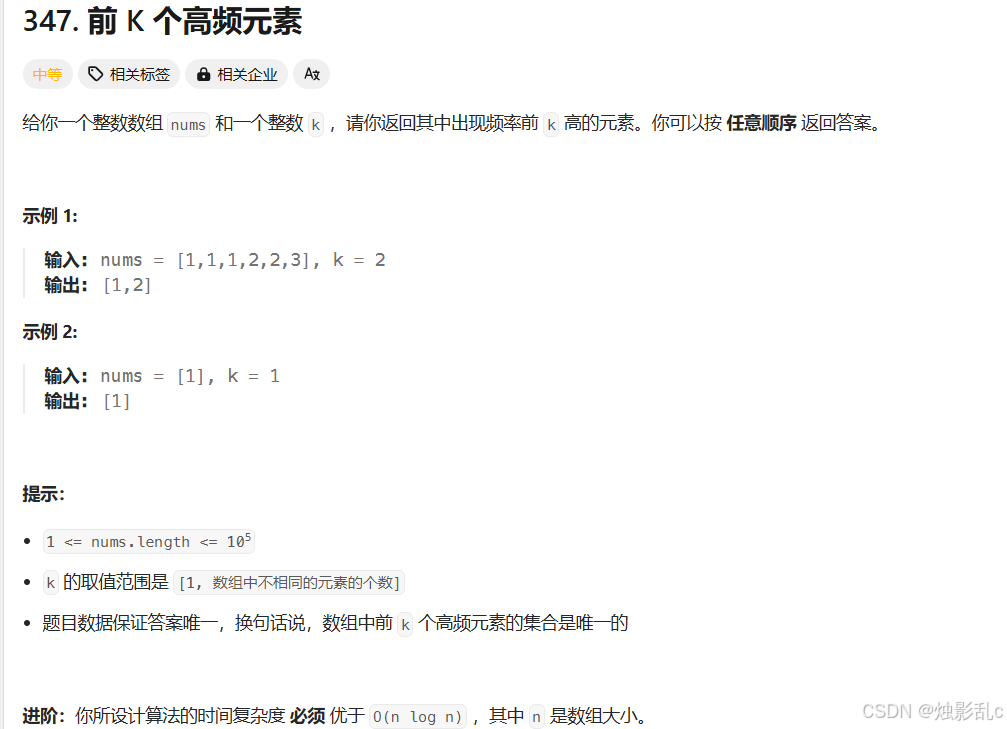
统计XX出现频率:HashMap
根据频率排序XX:优先级队列(PriorityQueue)的内部实现;绑定成[XX,频率]作为PriorityQueue的队员。
取出频率前K的XX:限制PriorityQueue容量为K。
PriorityQueue可以实现堆,默认为小顶堆。写个comparator来改为处理[XX,频率]的堆。在堆的K个成员里取最小值才能实现堆里留下K个最大值。
comparator.compare()底层逻辑:当compare()返回正值时,comparator认为左边的形参大于右边的形参。同理正负为小、平。所以只需在compare函数里运用左形参比较参数 - 右形参比较参数来return正负值即可。
Comparator只需要比较出两个形参大小就行,调用者再负责根据大小排序。
二叉树的迭代遍历模板:记住,模板的进栈顺序是根左。出栈顺序是左根。如果要前序,就在进栈时操作节点。中序则在出栈时操作节点。后序需要改模板,进栈顺序为根右,在进栈时《头插法》操作节点。
二叉树深度:递归。
二叉树直径:递归深度过程中,同时计算以该node为起点的路径,并与最大的进行比较。
此题需要知道的知识点:
1、任何一条路径都可由以某节点为起点,从其左儿子和右儿子向下遍历的路径拼接得到。(那么换句话说,遍历所有节点,并从每个节点出发,分别从其左儿子和右儿子向下遍历,可以得到所有可能的路径。)
2、一条路径的长度为该路径经过的节点数减一,所以要求路径长度就是求该路径上的节点数,那么就是求某个节点的左儿子和右儿子深度再+1.
所以在递归求深度的过程中计算出L和R后即可求某节点代表的路径节点数,递归过程中和全局变量ans对比留下最大的那个。最后不要忘记ans-1。

根据之前的知识点:任何一条路径都可由以某节点为起点,从其左儿子和右儿子向下遍历的路径拼接得到。(那么换句话说,遍历所有节点,并从每个节点出发,分别从其左儿子和右儿子向下遍历,可以得到所有可能的路径。)
我们只需要遍历所有节点,找到以每个节点为根节点(路径必包含根节点),分别向其左右儿子向下遍历即可。
那么我们需要写一个helper函数,输入root,返回经过root的路径的路径最大值(并且该路径可以和root的父节点组成新的路径)。
那么我们在递归过程中会有三个量来操作:left——经过左根的左树最大路径值,right——经过右根的右数最大路径值,root.val——根值。
怎么操作这三个量来返回经过根的当前树的最大路径值(并且该路径可和root父节点组成新路径)呢,我们先找到有哪些路径:只有根,左+根,右+根,左+右+根。但是左+右+根就不能再和其他父节点组成新路径了,所以helper返回时不能带上它,但是题目要求考虑所有路径,所以更新全局变量maxSum时需要考虑上。
验证二叉搜索树:中序遍历同时比较此节点值和上一节点值大小即可。
此题需要的知识点:二叉搜索树的中序遍历一定是升序的。
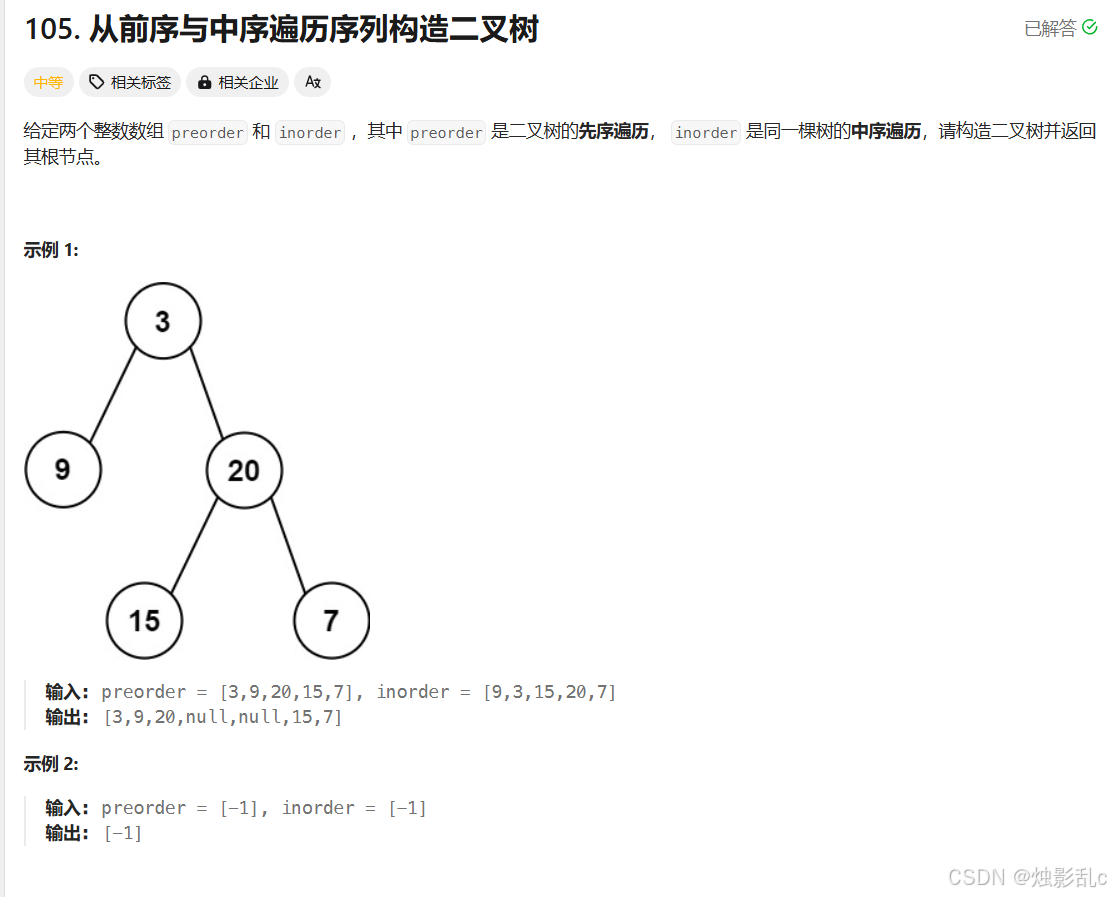
递归,递归函数helper作用:根据输入的preorder和inorder以及它们的start和end坐标,来构造该树。
helper的输入:整体的preorder和inorder,需要构建的子树的preorder的start和end;需要构建的子树的inorder的start和end。
helper的输出:构建好的子树的root节点。
递归出口:start > end;
递归逻辑:
找到根节点root。
root.left = helper(preorder,左子树preStart,左子树preEnd,inorder,左子树inStart,左子树inEnd).
所以关键的就是怎么用helper的输入preStart,preEnd,inStart,inEnd来求出左子树和右子树在preorder和inorder里的哪些start和end。这个在本上画图就行。
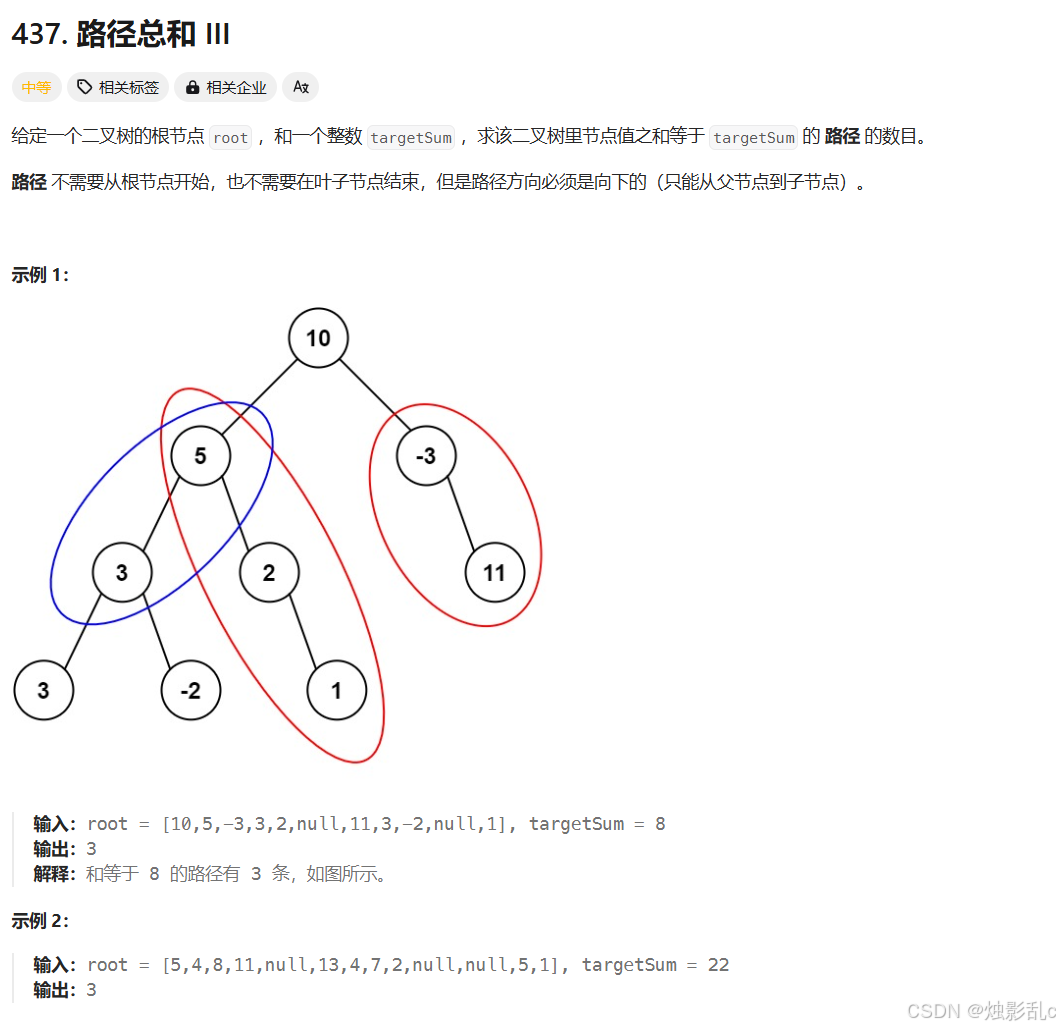
这道题给我的灵感就是,首先要搞清楚写的函数的功能。这个find函数的功能是:给你一棵树的根节点,返回 以这棵树所有节点为起始点,构成的路径值为T的值。
搞清楚函数功能后,想想能不能使用这个函数递归一下。发现,如果能找到以root节点为起点,构成的路径值为T的值count,再加上find(左子,T),和find(右子,T)就可以了。
所以问题转移到写找到以root节点为起点,构成的路径值为T的值,rootFind函数。一样,拿到一个函数首先考虑能不能递归使用它。如果rootFind(左子,T-root.val),rootFind(右子,T-root.val)知道,直接++就行。最后注意如果root.val ==T,也是要++的。
所以解决。
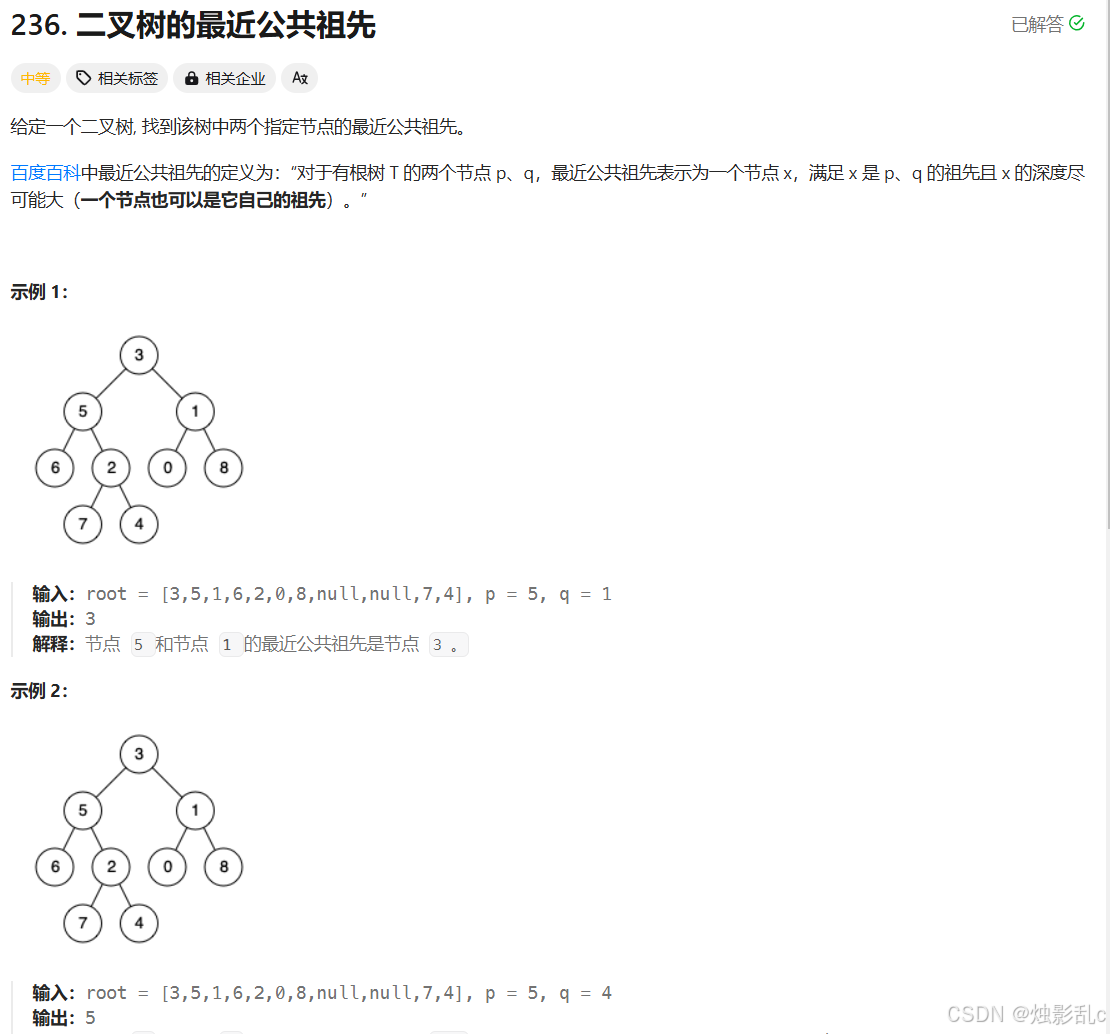
下笔之前一定要搞清我们要写的函数的作用:找到root这棵树内pq的最近公共祖先,并返回这个公共祖先节点。
首先我们要知道关键信息,pq一定在root这棵树里。那么就有三种情况。
1、root为p或q时,另外一个在左或右子树中。此时root为最近公共祖先,
2、root不为p或q时。(1)pq不在同一侧,此时root为公共祖先。(2)pq在同一侧时。此时需判断pq在哪一侧,将在的那一侧再调用lowestCommonAncestor即可。
所以我们另写一个函数existPOrQ:如果root这棵树内存在p或q任意一个就返回true。
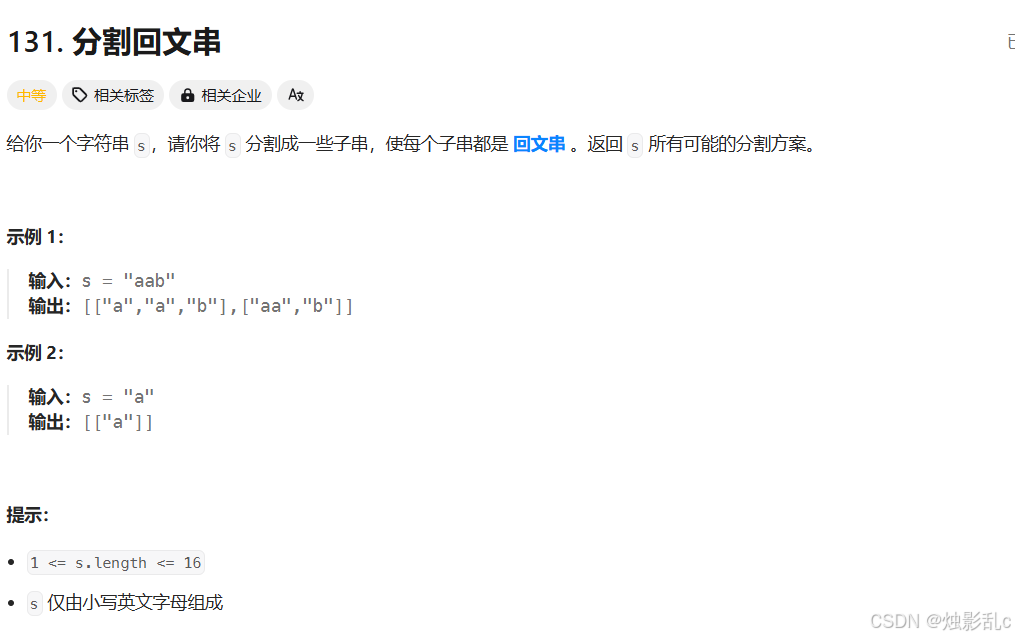
首先分割字串问题,画树时的第一层选择不一样!
以abcd为例,组合问题第一层如果i为1,就是从a开始,i=2就是从b开始。但是分割字符串,i =1,从a开始;i=2,是从ab开始!!不是从b开始。
还有个发现就是,for循环遵循:先选择(通过i来控制),再判断(循环体内设置条件)。
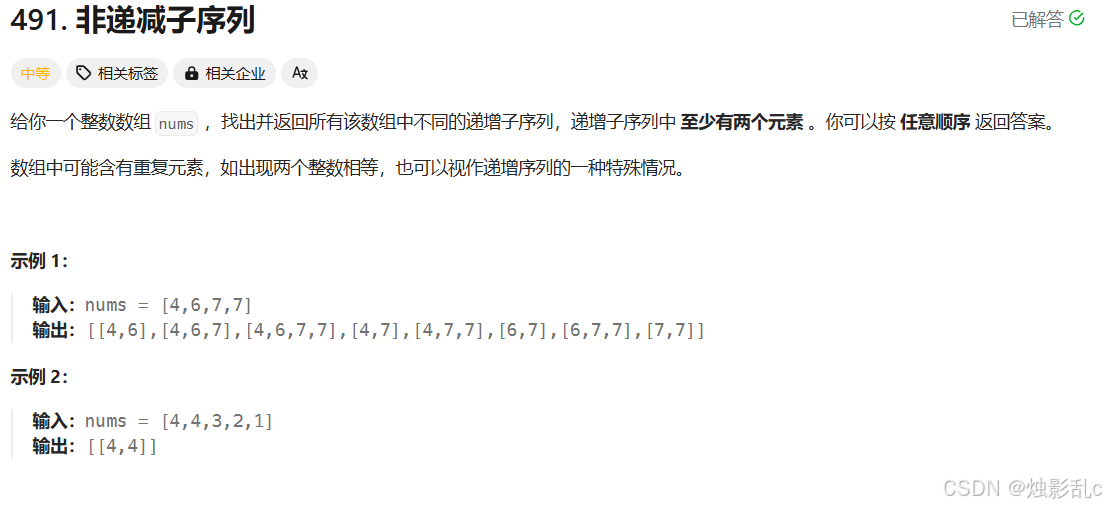
每层去重的方法: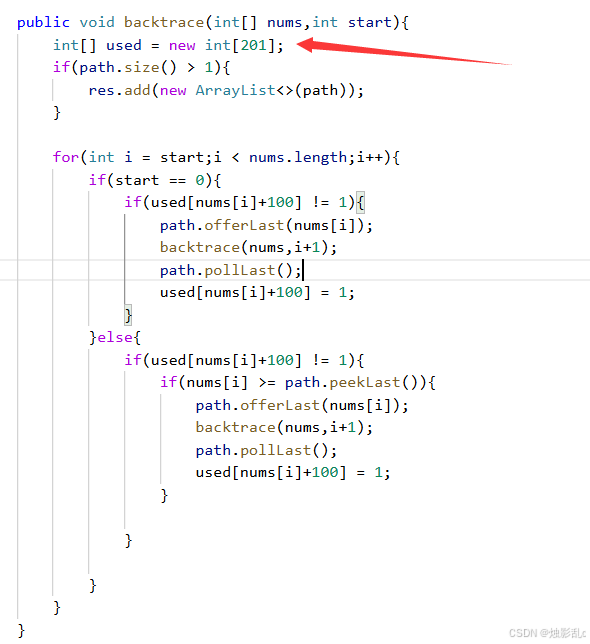
backtrace开头设置一个used数组,因为每一次backtrace就是一层。去重不仅要去除相邻两个数(用单变量last),还要去除不相邻(数组used)的两个数。
去重原因:第二个A能凑出来的情况,第一个A也能凑出来且比第二个多。如果同层再处理第二个A的话,res里面就有多余的path了。
同层去重:backtrace里面设置个int[] used数组。需要传入start,每次for循环从i = start开始。
同枝去重:设置个全局变量boolean[] used数组。不需要传入start,每次for循环从i = 0开始。
path加给res后,是否return是个很重要的点。如果需要进入下一层就不return;
回文子串的dp[i][j]定义!一定要围绕包括ij里的字串是否是回文(或最长子序列长度)。
黄金经验:先考虑递归,再dp,再技巧(如子数组和子串用前缀和。)
- 两数之和为target:哈希。
class Solution {
public int[] twoSum(int[] nums, int target) {
Map<Integer,Integer> map = new HashMap<>();
int[] res = new int[2];
for(int i = 0;i < nums.length;i++){
if(!map.containsKey(target - nums[i])){
map.put(nums[i],i);
}else{
res[0] = i;
res[1] = map.get(target - nums[i]);
return res;
}
}
return null;
}
}
- 异位词分组:哈希,key存排序后的词,value是list
class Solution {
Map<String,List<String>> map = new HashMap<>();
public List<List<String>> groupAnagrams(String[] strs) {
for(String s:strs){
char[] chs = s.toCharArray();
Arrays.sort(chs);
String sortchs = new String(chs);
List<String> temp = map.getOrDefault(sortchs,new ArrayList<String>());
temp.add(s);
map.put(sortchs,temp);
}
List<List<String>> res = new ArrayList<>();
for(Map.Entry<String,List<String>> e:map.entrySet()){
res.add(e.getValue());
}
return res;
}
}
- 最长连续序列:哈希set去重,找连续序列的最左数,找到则while循环至最右数同时max记录最大值
class Solution {
public int longestConsecutive(int[] nums) {
Set<Integer> set = new HashSet<>();
int res = 0;
for(int n:nums){
set.add(n);
}
for(int n:set){
int temp = 0;
if(!set.contains(n-1)){
do{
temp++;
n++;
}while(set.contains(n));
res = Math.max(res,temp);
}
}
return res;
}
}
- 移动0:双指针,每次将快指针的值覆盖慢指针,快指针遇0则跳过再覆盖,直至尾部,慢指针再赋0.
- 盛水最多容器:头尾双指针,移动矮端。
- 三数之和为0:排序,遍历时双指针,从头开始遍历,确定第一个数后,头尾双指针。注意sum==0时,n[L] == n[L+1]时需L++。
class Solution {
public List<List<Integer>> threeSum(int[] nums) {
List<List<Integer>> res = new ArrayList<>();
Arrays.sort(nums);
for(int i= 0;i < nums.length-2;i++){
if(i >0 && nums[i] == nums[i-1]){
continue;
}
if(nums[i] > 0){
break;
}
for(int m = i+1,n = nums.length -1;m < n;){
if(nums[i] + nums[m] + nums[n] == 0){
List<Integer> path = new ArrayList<>();
path.add(nums[i]);
path.add(nums[m]);
path.add(nums[n]);
res.add(path);
while(m < n && nums[m+1] == nums[m]){
m++;
}
while(m < n && nums[n-1] == nums[n]){
n--;
}
m++;
n--;
}else{
if(nums[i] + nums[m] + nums[n] > 0){
n--;
}else{
m++;
}
}
}
}
return res;
}
}
- 无重复字符的最长子串:双指针,set存储子串字符,ml,mr标记答案子串的左右下标。当重复时,l–至不重复。
class Solution {
public int lengthOfLongestSubstring(String s) {
if(s.length() == 0){
return 0;
}
Set<Character> set = new HashSet<>();
int ml=0,mr=1;
int left = 0,right = 1;
set.add(s.charAt(0));
while(right < s.length()){
if(!set.contains(s.charAt(right))){
set.add(s.charAt(right));
right++;
}else{
while(left<right && set.contains(s.charAt(right))){
set.remove(s.charAt(left));
left++;
}
set.add(s.charAt(right));
right++;
}
if(right - left > mr - ml){
ml = left;
mr = right;
}
}
return mr - ml;
}
}
- 找到字符串中所有字母异位词返回子串首字母下标:滑动窗口,从p中找q,用两个int[128]存字符出现次数,Arrays.equal比较是否相同。从p开始滑,滑出的字符在int[]里–,滑入的++,再equal。
class Solution {
public List<Integer> findAnagrams(String s, String p) {
if(s.length() < p.length()){
return new ArrayList<>();
}
List<Integer> res = new ArrayList<>();
int[] have = new int[128];
int[] need = new int[128];
for(char c:p.toCharArray()){
need[c]++;
}
for(int i = 0;i < p.length();i++){
have[s.charAt(i)]++;
}
if(Arrays.equals(have,need)){
res.add(0);
}
for(int i = p.length();i < s.length();i++){
have[s.charAt(i)]++;
have[s.charAt(i-p.length())]--;
if(Arrays.equals(have,need)){
res.add(i - p.length()+1);
}
}
return res;
}
}
- 和为 K 的子数组个数:前缀和。
- 滑动窗口最大值:递减队列存下标。从队尾入队,直至前面是比它大的。 每次滑动后判断队头是否滑出,滑出则删除队头。判断后再peek队头。
class Solution {
public int[] maxSlidingWindow(int[] nums, int k) {
Deque<Integer> deque = new LinkedList<>();
int[] res = new int[nums.length - k +1];
for(int i = 0;i <k;i++){
while(!deque.isEmpty()&&nums[deque.peekLast()]<= nums[i]){
deque.pollLast();
}
deque.offerLast(i);
}
res[0] = nums[deque.peekFirst()];
for(int i = k;i <nums.length;i++){
while(!deque.isEmpty()&&nums[deque.peekLast()] <= nums[i]){
deque.pollLast();
}
if(!deque.isEmpty()&&deque.peekFirst()<=i-k){
deque.pollFirst();
}
deque.offerLast(i);
res[i-k+1] = nums[deque.peekFirst()];
}
return res;
}
}
- 最小覆盖子串:从s中找覆盖t字符的最小子串,快慢指针,两个int[] need和have存放出现字符次数,count记录子串已有符合字符数,当count==tl时说明该子串符合,ml和mr记录该次下标,移动左界限,while循环至count != tl。当r的字符在need中且need >= have时count++。
class Solution {
public String minWindow(String s, String t) {
if (s == null || t == null || s.length() < t.length()) {
return "";
}
// 统计t中每个字符的频次
Map<Character, Integer> need = new HashMap<>();
for (char c : t.toCharArray()) {
need.put(c, need.getOrDefault(c, 0) + 1);
}
// 滑动窗口中字符的频次
Map<Character, Integer> window = new HashMap<>();
int left = 0, right = 0;
int valid = 0; // 窗口中满足need条件的字符个数
// 记录最小覆盖子串的起始索引及长度
int start = 0, len = Integer.MAX_VALUE;
while (right < s.length()) {
// c 是将移入窗口的字符
char c = s.charAt(right);
// 扩大窗口
right++;
// 进行窗口内数据的一系列更新
if (need.containsKey(c)) {
window.put(c, window.getOrDefault(c, 0) + 1);
if (window.get(c).equals(need.get(c))) {
valid++;
}
}
// 判断左侧窗口是否要收缩
while (valid == need.size()) {
// 在这里更新最小覆盖子串
if (right - left < len) {
start = left;
len = right - left;
}
// d 是将移出窗口的字符
char d = s.charAt(left);
// 缩小窗口
left++;
// 进行窗口内数据的一系列更新
if (need.containsKey(d)) {
if (window.get(d).equals(need.get(d))) {
valid--;
}
window.put(d, window.get(d) - 1);
}
}
}
// 返回最小覆盖子串
return len == Integer.MAX_VALUE ? "" : s.substring(start, start + len);
}
}
- 最大子数组和:dp
- 合并区间:Arrays.sort时用Comparator的compare排序左端点。遍历数组,比较当前区间左端点与集合内最后区间右端点,当>时,当前区间直接加入集合;<=时,更新记录的右端点即可。
class Solution {
public int[][] merge(int[][] intervals) {
List<int[]> temp = new ArrayList<>();
Arrays.sort(intervals,new Comparator<int[]>(){
public int compare(int[] interval1,int[] interval2){
return interval1[0] - interval2[0];
}
});
int left = intervals[0][0],right = intervals[0][1];
for(int i = 1;i < intervals.length;i++){
if(intervals[i][0] <= right){
right = Math.max(right,intervals[i][1]);
}else{
temp.add(new int[]{left,right});
left = intervals[i][0];
right = intervals[i][1];
}
}
temp.add(new int[]{left,right});
return temp.toArray(new int[temp.size()][]);
}
}
- 轮转数组:分段反转再整体反转。
- 除自身以外数组的乘积:两个数组存左和右的乘积,第一次遍历填充左右数组,第二次遍历填充res。
- 缺失的第一个正整数:理想的数组12-345,可以看出返回的是异常下标+1,所以我们目的就是怎么把输入数组转成理想数组,然后再遍历理想数组即可。从前往后遍历,当num[i] > 0 && <= length && num[i] != num[nums[i] - 1]。
class Solution {
public int firstMissingPositive(int[] nums) {
//众神归位法
int res = 0;
int nl = nums.length;
while(res < nl){
if(nums[res] == res + 1){
res++;
}else{
if(nums[res] > nl || nums[res] < res + 1||nums[nums[res] - 1] == nums[res]){
nums[res] = nums[nl - 1];
nl--;
}else{
int temp = nums[res];
nums[res] = nums[temp - 1];
nums[temp - 1] = temp;
}
}
}
return res+1;
}
}
- 如果一个元素为 0 ,则将其所在行和列的所有元素都设为 0:boolean[m]和boolean[n],遍历矩阵当遇0则对应boolean置true。再遍历m,n。
- 螺旋矩阵:模拟,四个指针,lt,rt,lb,rb。
class Solution {
public List<Integer> spiralOrder(int[][] matrix) {
List<Integer> res = new ArrayList<>();
int l = 0,r = matrix[0].length-1;
int t = 0,b = matrix.length-1;
while(l <=r && t <= b){
for(int i = l;i <= r&&t <= b;i++){
res.add(matrix[t][i]);
}
t++;
for(int i = t;i <= b&&l <= r;i++){
res.add(matrix[i][r]);
}
r--;
for(int i = r;i >=l&&t <= b;i--){
res.add(matrix[b][i]);
}
b--;
for(int i = b;i >= t&&l <= r;i--){
res.add(matrix[i][l]);
}
l++;
}
return res;
}
}
- 旋转图像:先水平翻转,再主对角线。
class Solution {
public void rotate(int[][] matrix) {
int temp;
for(int i = 0;i < matrix.length ;i++){
for(int j = 0 ;j < matrix.length ;j++){
if(matrix.length - 1 -i > i){
temp = matrix[i][j];
matrix[i][j] = matrix[matrix.length - 1 - i][j];
matrix[matrix.length - 1 - i][j] = temp;
}
}
}
for(int i = 0;i < matrix.length - 1;i++ ){
for(int j = i + 1;j < matrix.length;j++){
temp = matrix[i][j];
matrix[i][j] = matrix[j][i];
matrix[j][i] = temp;
}
}
}
}
- 搜索有序矩阵:右上角开始,要么行++,要么列–。
- 相交链表:每次向前走,遇null则重置到另个链表头节点,直至A == B。
- 反转链表:递归
- 判断回文链表:翻转后半部分再遍历比较。
- 环形链表:快慢指针,快走两步,慢走一步,相遇反true。如果需环入口,相遇快重置至head,同走一步,直至相遇。
- 合并两个有序链表:新建res指向最小节点,temp指向结果链表的尾节点,将temp.next指向两者最小,直至list1为null或者list2为null。再把temp.next指向非null。递归更简单,找到最小值再用递归即可。
class Solution {
public ListNode mergeTwoLists(ListNode list1, ListNode list2) {
if(list1 == null && list2 == null){
return null;
}
if(list1 == null && list2 != null){
return list2;
}
if(list2 == null && list1 != null){
return list1;
}
ListNode temp;
if(list1.val <= list2.val){
temp = list1;
list1 = list1.next;
}else{
temp = list2;
list2 = list2.next;
}
ListNode res = temp;
while(list1 != null && list2!= null){
if(list1.val <= list2.val){
temp.next = list1;
list1 = list1.next;
}else{
temp.next = list2;
list2 = list2.next;
}
temp = temp.next;
}
ListNode list = list1 == null?list2:list1;
temp.next = list;
return res;
}
}
- 逆序链表两数相加:新建res指向开头,temp指向尾节点,carrier表示进数,当l1 != null或 l2!= null或 carrier != 0时都进入循环算sum,然后利用sum新建节点接入temp,更新carrier,l1 l2更新
class Solution {
public ListNode addTwoNumbers(ListNode l1, ListNode l2) {
ListNode res = new ListNode();
ListNode temp = res;
int carrier = 0;
while(l1 != null || l2 != null || carrier != 0){
int sum = (l1 == null?0:l1.val) + (l2 == null?0:l2.val) +carrier;
temp.next = new ListNode(sum % 10);
temp = temp.next;
carrier = sum / 10;
if(l1 != null){
l1 = l1.next;
}
if(l2 != null){
l2 = l2.next;
}
}
return res.next;
}
}
- 删除链表倒数第N个节点:新建res指向开头,使正常删除头节点,再快慢指针。
- 两两交换链表中的节点:递归
class Solution {
public ListNode swapPairs(ListNode head) {
return change(head);
}
public ListNode change(ListNode node){
if(node == null){
return null;
}
if(node.next == null){
return node;
}
ListNode res = node.next;
node.next = change(node.next.next);
res.next = node;
return res;
}
}
- K 个一组翻转链表:运用reverse翻转链表函数,新建res节点为前驱节点,pre也为前驱节点,遍历end到小链表最后一个元素,提前标记下个小链表开头,以便pre过去。
public ListNode reverseKGroup(ListNode head, int k) {
ListNode dummy = new ListNode(0);
dummy.next = head;
ListNode pre = dummy;
ListNode end = dummy;
while (end.next != null) {
for (int i = 0; i < k && end != null; i++) end = end.next;
if (end == null) break;
ListNode start = pre.next;
ListNode next = end.next;
end.next = null;
pre.next = reverse(start);
start.next = next;
pre = start;
end = pre;
}
return dummy.next;
}
private ListNode reverse(ListNode head) {
ListNode pre = null;
ListNode curr = head;
while (curr != null) {
ListNode next = curr.next;
curr.next = pre;
pre = curr;
curr = next;
}
return pre;
}
- 排序链表:递归+归并排序。
class Solution {
public ListNode sortList(ListNode head) {
if(head == null){
return null;
}
if(head.next == null){
return head;
}
ListNode res = new ListNode();
res.next = head;
ListNode slow = res,quick = res;
while(quick.next != null){
quick = quick.next;
if(quick.next != null){
quick= quick.next;
}
slow = slow.next;
}
ListNode next = slow.next;
slow.next = null;
ListNode left = sortList(res.next);
ListNode right = sortList(next);
return merge(left,right);
}
public ListNode merge(ListNode left,ListNode right){
ListNode res = new ListNode();
ListNode ress = res;
while(left!=null && right != null){
if(left.val <= right.val){
ress.next = new ListNode(left.val);
left = left.next;
}else{
ress.next = new ListNode(right.val);
right = right.next;
}
ress = ress.next;
}
ListNode temp = left == null?right:left;
ress.next = temp;
return res.next;
}
}
- 合并 K 个升序链表:多次运用合并两个升序链表函数。
class Solution {
public ListNode mergeKLists(ListNode[] lists) {
if(lists == null){
return null;
}
Set<ListNode> picked = new HashSet<>();
List<ListNode> listhead = new ArrayList<>();
for(ListNode n:lists){
if(picked.contains(n)){
continue;
}
if(n == null){
continue;
}else{
listhead.add(n);
while(n.next != null){
n = n.next;
picked.add(n);
}
}
}
if(listhead.isEmpty()){
return null;
}
if(listhead.size() == 1){
return listhead.get(0);
}
ListNode res = new ListNode();
res.next = merge(listhead.get(0),listhead.get(1));
for(int i = 2;i < listhead.size();i++){
res.next = merge(res.next,listhead.get(i));
}
return res.next;
}
public ListNode merge(ListNode left,ListNode right){
ListNode res = new ListNode();
ListNode ress = res;
while(left!=null && right != null){
if(left.val <= right.val){
ress.next = new ListNode(left.val);
left = left.next;
}else{
ress.next = new ListNode(right.val);
right = right.next;
}
ress = ress.next;
}
ListNode temp = left == null?right:left;
ress.next = temp;
return res.next;
}
}
- LRU缓存:使用Node<key,val>存放元素,并且Node类里有next和pre指针,也就是说使用双向链表记录优先级;使用hashset记录是否存在此Key。用head和tail记录头尾。当刚put或访问时,将key对应node移到队尾。
class Node{
int key;
int value;
Node next;
Node pre;
public Node(){};
public Node(int key,int value){
this.key = key;
this.value = value;
}
}
class LRUCache {
Map<Integer,Node> map = new HashMap<>();
int capacity;
Node first = new Node();
Node last = new Node();
public LRUCache(int capacity) {
this.capacity = capacity;
first.next = last;
last.pre = first;
}
public int get(int key) {
Node temp = map.getOrDefault(key,null);
if(null == temp){
return -1;
}else{
temp.pre.next = temp.next;
temp.next.pre = temp.pre;
temp.pre = last.pre;
temp.next = last;
last.pre.next = temp;
last.pre = temp;
return temp.value;
}
}
public void put(int key, int value) {
Node temp = map.getOrDefault(key,null);
if(null == temp){
temp = new Node(key,value);
map.put(key,temp);
temp.next = last;
temp.pre = last.pre;
last.pre.next = temp;
last.pre = temp;
}else{
temp.value = value;
temp.pre.next = temp.next;
temp.next.pre = temp.pre;
temp.pre = last.pre;
temp.next = last;
last.pre.next = temp;
last.pre = temp;
}
if(map.size() > capacity){
map.remove(first.next.key);
first.next.next.pre = first;
first.next = first.next.next;
}
}
}
- 二叉树中序,前序:模板。
class Solution {
public List<Integer> inorderTraversal(TreeNode root) {
List<Integer> res = new ArrayList<>();
Deque<TreeNode> stack = new LinkedList<>();
while(root != null){
stack.offerLast(root);
root = root.left;
}
while(!stack.isEmpty()){
TreeNode n = stack.pollLast();
res.add(n.val);
TreeNode r = n.right;
while(r != null){
stack.offerLast(r);
r = r.left;
}
}
return res;
}
}
- 二叉树后序:将根左变为根右。入栈时头插。
class Solution {
public List<Integer> postorderTraversal(TreeNode root) {
List<Integer> res = new ArrayList<>();
Deque<TreeNode> stack = new LinkedList<>();
while(root != null){
stack.offerLast(root);
res.add(0,root.val);
root = root.right;
}
while(!stack.isEmpty()){
TreeNode n = stack.pollLast();
TreeNode l = n.left;
while(l != null){
stack.offerLast(l);
res.add(0,l.val);
l = l.right;
}
}
return res;
}
}
- 二叉树最大深度:队列,层序遍历。
- 翻转二叉树:递归
class Solution {
public TreeNode invertTree(TreeNode root) {
if(root == null){
return null;
}
invertTree(root.left);
invertTree(root.right);
TreeNode l = root.left;
root.left = root.right;
root.right = l;
return root;
}
}
- 判断对称二叉树:递归,新建函数hlper为判断left和right是否对称。
class Solution {
public boolean isSymmetric(TreeNode root) {
if(root == null){
return true;
}
return dfs(root.left,root.right);
}
public boolean dfs(TreeNode left,TreeNode right){
if(left == null && right == null){
return true;
}
if(left == null || right == null){
return false;
}
if(left.val != right.val){
return false;
}
return dfs(left.left,right.right)&&dfs(left.right,right.left);
}
}
- 树中任意两个节点之间最长路径的长度:新建函数判断节点最长半边路径。过程中用res记录最长双边长度。
class Solution {
int ans;
public int diameterOfBinaryTree(TreeNode root) {
ans = 1;
depth(root);
return ans -1;
}
public int depth(TreeNode node){
if(node == null){
return 0;
}
int L = depth(node.left);
int R = depth(node.right);
ans = Math.max(ans,L+R+1);
return Math.max(L,R)+1;
}
}
- 将有序数组转换为二叉搜索树:新建hlepr传入数组和左右下标递归构建二叉搜索树。
class Solution {
public TreeNode sortedArrayToBST(int[] nums) {
return helper(nums,0,nums.length-1);
}
public TreeNode helper(int[] nums,int left,int right){
if(left > right){
return null;
}
int mid = (left + right)/2;
TreeNode root = new TreeNode(nums[mid]);
root.left = helper(nums,left,mid-1);
root.right = helper(nums,mid+1,right);
return root;
}
}
- 验证二叉搜索树:二叉搜索树的中序遍历是升序的。
- 路径总和为t:递归,结果为this(root.left,t)+this(root.right,t)+helper(root,t),其中helper是求 必包括root时的路径数量,helper也是递归
class Solution {
public int pathSum(TreeNode root, int targetSum) {
if(root == null){
return 0;
}
return helper(root,targetSum)+pathSum(root.left,targetSum)+pathSum(root.right,targetSum);
}
public int helper(TreeNode root,long target){
if(root == null){
return 0;
}
int count = 0;
if(root.val == target){
count = 1;
}
int left = helper(root.left,target - root.val);
int right = helper(root.right,target - root.val);
return left + right+count;
}
}
- 二叉树公共祖先:hleper为监测某节点是否在当前树中。如果p与q都在root.left中,则return this(root.left)。如果pq不在同一子树中,return root。
class Solution {
public TreeNode lowestCommonAncestor(TreeNode root, TreeNode p, TreeNode q) {
if(root == p ||root == q){
return root;
}
if(existPOrQ(root.left,p,q)&&existPOrQ(root.right,p,q)){
return root;
}
if(existPOrQ(root.left,p,q)){
return lowestCommonAncestor(root.left,p,q);
}else{
return lowestCommonAncestor(root.right,p,q);
}
}
public boolean existPOrQ(TreeNode root,TreeNode p,TreeNode q){
if(root == null){
return false;
}
if(root.val == p.val || root.val == q.val){
return true;
}
return existPOrQ(root.left,p,q) || existPOrQ(root.right,p,q);
}
}
- 最大路径和:路径可以对折,那么求每个节点的最大路径和,同时取max即可。helper求 包括root时最大的边路径和。那么root的最大路径和就三种情况:只有自己,自己+helper(root.left),自己+helper(root.right).
class Solution {
int res = Integer.MIN_VALUE;
public int maxPathSum(TreeNode root) {
helper(root);
return res;
}
public int helper(TreeNode root){
if(root == null){
return 0;
}
int left = helper(root.left);
int right = helper(root.right);
int max = Math.max(Math.max(left,right)+root.val,root.val);
int maxpath = Math.max(root.val,Math.max(root.val+left,Math.max(root.val+right,root.val+left+right)));
res = Math.max(res,maxpath);
return max;
}
}
- 岛屿数量:给你一个由 ‘1’(陆地)和 ‘0’(水)组成的的二维网格,请你计算网格中岛屿的数量。
class Solution {
public int numIslands(char[][] grid) {
int count = 0;
for(int i = 0; i < grid.length; i++) {
for(int j = 0; j < grid[0].length; j++) {
if(grid[i][j] == '1'){
dfs(grid, i, j);
count++;
}
}
}
return count;
}
private void dfs(char[][] grid, int i, int j){
if(i < 0 || j < 0 || i >= grid.length || j >= grid[0].length || grid[i][j] == '0') return;
grid[i][j] = '0';
dfs(grid, i + 1, j);
dfs(grid, i, j + 1);
dfs(grid, i - 1, j);
dfs(grid, i, j - 1);
}
}
- N皇后:
class Solution {
List<List<String>> res = new ArrayList<>();
Deque<String> path = new LinkedList<>();
boolean[][] used;
public List<List<String>> solveNQueens(int n) {
used =new boolean[n][n];
backtrace(n,0);
return res;
}
public void backtrace(int n,int row){
if(row == n){
res.add(new ArrayList(path));
return;
}
for(int i = 0;i < n;i++){
if(check(row,i,n)){
path.offerLast(makePath(n,i));
used[row][i]= true;
backtrace(n,row+1);
used[row][i] = false;
path.pollLast();
}
}
}
public boolean check(int m,int n,int max){
for(int i = m;i >=0;i--){
if(used[i][n]){
return false;
}
}
for(int i = m,j = n;i >=0&&j>=0;i--,j--){
if(used[i][j]){
return false;
}
}
for(int i = m,j = n;i >=0&&j<max;i--,j++){
if(used[i][j]){
return false;
}
}
return true;
}
public String makePath(int n,int j){
StringBuilder sb = new StringBuilder();
for(int i = 0;i < n;i++){
if(i != j){
sb.append('.');
}else{
sb.append('Q');
}
}
return sb.toString();
}
}
- 分割回文子串:
class Solution {
List<List<String>> res = new ArrayList<>();
Deque<String> path = new LinkedList<>();
public List<List<String>> partition(String s) {
backtrace(s.toCharArray(),0);
return res;
}
public void backtrace(char[] chars,int start){
if(start == chars.length){
res.add(new ArrayList(path));
return;
}
for(int i = start;i < chars.length;i++){
if(check(chars,start,i)){
path.offerLast(new String(chars,start,i - start +1));
backtrace(chars,i+1);
path.pollLast();
}
}
}
public boolean check(char[] chars,int start,int end){
while(end >= start){
if(chars[start++] != chars[end--]){
return false;
}
}
return true;
}
}
- 单词搜索:
class Solution {
Deque<Character> path = new LinkedList<>();
boolean[][] usedZ;
public boolean exist(char[][] board, String word) {
int res;
usedZ = new boolean[board.length][board[0].length];
for(int i = 0;i < board.length;i++){
for(int j = 0;j < board[0].length;j++){
if(backtrace(board,word.toCharArray(),i,j,0)){
return true;
}
}
}
return false;
}
public boolean backtrace(char[][] board,char[] word,int m,int n,int index){
if(index == word.length){
return true;
}
if(m <0 || m >= board.length || n < 0||n >= board[0].length||usedZ[m][n] || board[m][n] != word[index]){
return false;
}
usedZ[m][n] = true;
boolean res = backtrace(board,word,m,n+1,index+1)||
backtrace(board,word,m+1,n,index+1)||
backtrace(board,word,m,n-1,index+1)||
backtrace(board,word,m-1,n,index+1);
usedZ[m][n] = false;
return res;
}
public boolean check(Deque<Character> path,char[] word){
int i =0;
for(char c:path){
if(c != word[i]){
return false;
}
i++;
}
return true;
}
}
- n对括号可生成的所有有效组合:
class Solution {
List<String> res = new ArrayList<>();
Deque<Character> path = new LinkedList<>();
int[] used = new int[2];
public List<String> generateParenthesis(int n) {
backtrace(n);
return res;
}
public void backtrace(int n){
if(path.size() == 2*n){
if(helper(path)){
StringBuilder sb = new StringBuilder();
for(char c:path){
sb.append(c);
}
res.add(sb.toString());
}
return;
}
for(int i = 0;i <used.length;i++){
if(used[i] >n){
continue;
}
if(i == 0){
path.offerLast('(');
used[i]++;
backtrace(n);
path.pollLast();
used[i]--;
}else{
path.offerLast(')');
used[i]++;
backtrace(n);
path.pollLast();
used[i]--;
}
}
}
public boolean helper(Deque<Character> path){
Deque<Character> stack = new LinkedList<>();
for(char c:path){
if(c == '('){
stack.offerLast(')');
}else{
if(stack.isEmpty()){
return false;
}else{
stack.pollLast();
}
}
}
if(!stack.isEmpty()){
return false;
}
return true;
}
}
45. 组合总成:给你一个 无重复元素 的整数数组 candidates 和一个目标整数 target ,找出 candidates 中可以使数字和为目标数 target 的 所有 不同组合 ,并以列表形式返回。你可以按 任意顺序 返回这些组合。candidates 中的 同一个 数字可以 无限制重复被选取 。如果至少一个数字的被选数量不同,则两种组合是不同的。
class Solution {
List<List<Integer>> res = new ArrayList<>();
Deque<Integer> path = new LinkedList<>();
int sum = 0;
public List<List<Integer>> combinationSum(int[] candidates, int target) {
backtrace(candidates,target,0);
return res;
}
public void backtrace(int[] candidates, int target,int begin){
if(sum > target){
return;
}
if(sum == target){
res.add(new ArrayList(path));
return;
}
for(int i = begin;i < candidates.length;i++){
path.offerLast(candidates[i]);
sum += candidates[i];
backtrace(candidates,target,i);
path.pollLast();
sum -= candidates[i];
}
}
}
- 电话号码组合:
class Solution {
List<String> res = new ArrayList<>();
Deque<Character> path = new LinkedList<>();
String[] number = {"abc", "def", "ghi", "jkl", "mno", "pqrs", "tuv", "wxyz"};
public List<String> letterCombinations(String digits) {
if(digits.length() == 0){
return new ArrayList();
}
char[] chars = digits.toCharArray();
backtrace(chars,0);
return res;
}
public void backtrace(char[] digits,int index){
if(index == digits.length){
StringBuilder sb = new StringBuilder();
for(char c:path){
sb.append(c);
}
res.add(sb.toString());
return;
}
for(int i = 0;i < number[digits[index]-'0'-2].length();i++){
path.offerLast(number[digits[index]-'0'-2].charAt(i));
backtrace(digits,index+1);
path.pollLast();
}
}
}
- 子集:
class Solution {
List<List<Integer>> res = new ArrayList<>();
Deque<Integer> path = new LinkedList<>();
public List<List<Integer>> subsets(int[] nums) {
backtrace(nums,0);
return res;
}
public void backtrace(int[] nums,int index){
res.add(new ArrayList(path));
for(int i = index;i <nums.length;i++){
path.offerLast(nums[i]);
backtrace(nums,i+1);
path.pollLast();
}
}
}
- 全排列:
class Solution {
List<List<Integer>> res = new ArrayList<>();
Deque<Integer> path = new LinkedList<>();
boolean[] used = new boolean[21];
public List<List<Integer>> permute(int[] nums) {
backtrace(nums);
return res;
}
public void backtrace(int[] nums){
if(path.size() == nums.length){
res.add(new ArrayList(path));
return;
}
for(int i = 0;i < nums.length;i++){
if(used[nums[i]+10]){
continue;
}else{
path.offerLast(nums[i]);
used[nums[i]+10] = true;
backtrace(nums);
path.pollLast();
used[nums[i] +10] =false;
}
}
}
}
- 在排序数组中查找给定元素的起始和结尾位置:
class Solution {
public int[] searchRange(int[] nums, int target) {
int left = 0;
int right = nums.length - 1;
int first = -1;
int last = -1;
// 找第一个等于target的位置
while (left <= right) {
int middle = (left + right) / 2;
if (nums[middle] == target) {
first = middle;
right = middle - 1; //重点
} else if (nums[middle] > target) {
right = middle - 1;
} else {
left = middle + 1;
}
}
// 最后一个等于target的位置
left = 0;
right = nums.length - 1;
while (left <= right) {
int middle = (left + right) / 2;
if (nums[middle] == target) {
last = middle;
left = middle + 1; //重点
} else if (nums[middle] > target) {
right = middle - 1;
} else {
left = middle + 1;
}
}
return new int[]{first, last};
}
}
- 搜索旋转排序数组:先判断mid左右哪段有序,再判断target在不在有序范围内。在有序范围内,则给某个边界赋值mid+1或-1。直至left > right。
class Solution {
public int search(int[] nums, int target) {
int left =0,right = nums.length - 1;
while(left < right){
int mid = (left + right) /2;
if(nums[mid] == target ){
return mid;
}
if(nums[mid] > nums[right]){
//说明[left,mid]肯定有序
if(target>=nums[left]&&target < nums[mid]){
right = mid -1;
}else{
left = mid +1;
}
}else{
//[mid,right]肯定有序
if(target > nums[mid] && target <= nums[right]){
left = mid+1;
}else{
right = mid - 1;
}
}
}
return nums[left] ==target?left:-1;
}
}
- 寻找旋转排序数组中的最小值:同理根据mid和right大小判断哪段有序,再把有序中的最小值和res比较,然后赋值为mid+1或-1.
class Solution {
public int findMin(int[] nums) {
int left = 0,right = nums.length -1;
int res = Integer.MAX_VALUE;
while(left <= right){
int mid = (left + right) /2;
if(nums[mid] < nums[right]){
//[mid,right]有序
res = Math.min(res,nums[mid]);
right = mid -1;
}else{
res= Math.min(res,nums[left]);
left = mid + 1;
}
}
return res;
}
}
- 找两个正序数组中位数:helper函数求两个有序数组中第K大的数。每次比较A与B中第k/2个数即比较cindex=index+k/2-1,忽略较小的一个的这k/2个数,即有效下标起始值为cindex+1。然后k= k - cindex +1。直至k==1或者index越界。
class Solution {
public double findMedianSortedArrays(int[] nums1, int[] nums2) {
int len1 = nums1.length,len2 = nums2.length;
if((len1 + len2) %2 ==1){
return helper(nums1,nums2,(len1 + len2 ) /2+1);
}else{
int m = helper(nums1,nums2,(len1 + len2) /2);
int n = helper(nums1,nums2,(len1 + len2) /2+1);
return (m+n)/2.0;
}
}
public int helper(int[] nums1,int[] nums2,int k){
int index1 =0,index2 = 0;
while(true){
if(index1 == nums1.length){
return nums2[index2 + k -1];
}
if(index2 == nums2.length){
return nums1[index1 + k - 1];
}
if(k == 1){
return Math.min(nums1[index1],nums2[index2]);
}
int cindex1 = Math.min(index1+k/2,nums1.length) -1;
int cindex2 = Math.min(index2+k/2,nums2.length) -1;
if(nums1[cindex1] <= nums2[cindex2]){
k = k -(cindex1 - index1 + 1);
index1 = cindex1 +1;
}else{
k = k - (cindex2 - index2 +1);
index2 = cindex2 +1;
}
}
}
}
- 最小栈:
class MinStack {
PriorityQueue<Integer> pq = new PriorityQueue<>();
Deque<Integer> numStack = new LinkedList<>();
public MinStack() {
}
public void push(int val) {
pq.add(val);
numStack.offerLast(val);
}
public void pop() {
pq.remove(top());
numStack.pollLast();
}
public int top() {
return numStack.peekLast();
}
public int getMin() {
return pq.peek();
}
}
- 字符串解码:从前往后遍历s,遇到0-9让num=num*10+c,遇到字母则sb.append,遇到 [ 则strStack存放sb,sb置新,numStack存放该次num,num置0,遇到】则取出num,再进行num此的sb重复并拼接到strStack中的preSb。最后返回sb。
class Solution {
public String decodeString(String s) {
StringBuilder sb = new StringBuilder();
Deque<Integer> numStack = new LinkedList<>();
Deque<String> strStack = new LinkedList<>();
int num= 0;
for(int i = 0;i < s.length();i++){
char c = s.charAt(i);
if(c >= '0' && c <= '9'){
num = num*10 + c -'0';
}else if((c >= 'a' && c <= 'z') || (c >= 'A' && c <= 'Z')){
sb.append(c);
}else if(c == '['){
strStack.offerLast(sb.toString());
sb = new StringBuilder();
numStack.offerLast(num);
num = 0;
}else{
StringBuilder preSb = new StringBuilder().append(strStack.pollLast());
int times = numStack.pollLast();
for(int j = 0;j < times;j++){
preSb.append(sb);
}
sb = preSb;
}
}
return sb.toString();
}
}
- 每日温度:求下一个第一个更高温度出现在几天后(求右边第一个更大数的下标)。单调栈存下标,当前num[i]大于num[last]则ans[polllast]=i。
class Solution {
public int[] dailyTemperatures(int[] temperatures) {
int[] res= new int[temperatures.length];
Deque<Integer> stack = new LinkedList<>();
for(int i=0;i < temperatures.length;i++){
while(!stack.isEmpty()&&temperatures[i] > temperatures[stack.peekLast()]){
int now = stack.pollLast();
res[now] = i - now;
}
stack.offerLast(i);
}
return res;
}
}
- 无序数组中第K大元素值:K容量最小堆(PriorityQueue)。当size < k时直接offer,否则判断peek和num[i],如果peek大则跳过,否则poll,再offer。最后取出peek返回。
public int findKthLargest(int[] nums, int k) {
final PriorityQueue<Integer> queue = new PriorityQueue<>();
for (int val : nums) {
queue.add(val);
if (queue.size() > k)
queue.poll();
}
return queue.peek();
}
著作权归作者所有。商业转载请联系作者获得授权,非商业转载请注明出处。
51. 前 K 个高频元素:频率用hashmap统计,前K用最小堆,最后遍历最小堆。
class Solution {
public int[] topKFrequent(int[] nums, int k) {
int[] res = new int[k];
int i = 0;
Map<Integer,Integer> map = new HashMap<>();
for(int n:nums){
map.put(n,map.getOrDefault(n,0)+1);
}
PriorityQueue<Map.Entry<Integer,Integer>> pq = new PriorityQueue<>(new Comparator<Map.Entry<Integer,Integer>>(){
public int compare(Map.Entry<Integer,Integer> o1,Map.Entry<Integer,Integer> o2){
return o1.getValue() - o2.getValue();
}
});
for(Map.Entry<Integer,Integer> e:map.entrySet()){
if(pq.size() < k){
pq.offer(e);
}else{
if(e.getValue() > pq.peek().getValue()){
pq.poll();
pq.offer(e);
}
}
}
for(Map.Entry<Integer,Integer> e:pq){
res[i++] = e.getKey();
}
return res;
}
}
- 买卖股票:
public class Solution {
public int maxProfit(int[] prices) {
int len = prices.length;
// 特殊判断
if (len < 2) {
return 0;
}
int[][] dp = new int[len][2];
// dp[i][0] 下标为 i 这天结束的时候,不持股,手上拥有的现金数
// dp[i][1] 下标为 i 这天结束的时候,持股,手上拥有的现金数
// 初始化:不持股显然为 0,持股就需要减去第 1 天(下标为 0)的股价
dp[0][0] = 0;
dp[0][1] = -prices[0];
// 从第 2 天开始遍历
for (int i = 1; i < len; i++) {
dp[i][0] = Math.max(dp[i - 1][0], dp[i - 1][1] + prices[i]);
dp[i][1] = Math.max(dp[i - 1][1], -prices[i]);
}
return dp[len - 1][0];
}
}
- 跳跃游戏:判断能否到达。nums最大跳跃长度。遍历nums,用end记录最长下标,当end>= i时end和i+nums[i]比较取最大。
class Solution {
public boolean canJump(int[] nums) {
boolean[] path = new boolean[nums.length];
path[0] = true;
for(int i = 0;i < nums.length - 1 && path[i];i++){
for(int j = 1; j <= nums[i];j++){
if(i + j < path.length){
path[i+j] = true;
}
}
}
return path[nums.length - 1];
}
}
- 跳跃游戏进阶:返回跳跃次数的最小值。用end记录当前跳跃最长下标,maxPos记录已知可达最大下标,当i==end时,说明当前次的跳跃已经知道跳到哪maxPo最大了,所以end=maxPo,step++。
class Solution {
public int jump(int[] nums) {
if(nums.length == 1){
return 0;
}
int res = 0;
int last = find(nums,nums.length - 1);
res++;
while(last >0){
last = find(nums,last);
res++;
}
return res;
}
public int find(int[] nums,int index){
for(int i = 0;i < nums.length - 1;i++){
if(nums[i] + i >= index){
return i;
}
}
return -1;
}
}
- 划分字母区间:int[] last存字母最后出现下标。用start,end记录当前子串下标,遍历s,end更新为last[s[i] - ‘a’]和end的最大值,直至i==end,res.add,然后start=end+1.
class Solution {
public List<Integer> partitionLabels(String s) {
int l = s.length();
int[] last = new int[26];
for(int i = 0; i < l;i++){
last[s.charAt(i) - 'a'] = i;
}
List<Integer> res = new ArrayList<>();
int start = 0,end = 0;
for(int i = 0;i < l;i++){
end = Math.max(end,last[s.charAt(i) - 'a']);
if(end == i){
res.add(end - start + 1);
start = end + 1;
}
}
return res;
}
}
- 打家劫舍:相邻房间不能抢。dp[i]为抢前i家的最大金钱。dp[i] = max(dp[i-1],dp[i-2]+nums[i-1])。
class Solution {
public int rob(int[] nums) {
int l = nums.length;
int[] dp = new int[l+1];
dp[0] = 0;
dp[1] = nums[0];
for(int i = 2;i < dp.length;i++){
dp[i] = Math.max(dp[i-1],dp[i-2]+nums[i-1]);
}
return dp[l];
}
}
- 返回 和为 n 的完全平方数的最少数量 :dp[i]和为i的完全平方数最少数量。完全背包问题,先物品再背包。i从1,ii<=n,i++。dp[j] = min(dp[i],dp[j-ii]+1)。
class Solution {
public int numSquares(int n) {
int[] dp = new int[n+1];
for(int i = 0;i < dp.length;i++){
dp[i] = i;
}
for(int i = 2;i * i <= n;i++){
for(int j = 0;j <= n;j++){
if(i*i <= j){
dp[j] = Math.min(dp[j - i*i]+1,dp[j]);
}
}
}
return dp[n];
}
}
- 计算并返回可以凑成总金额所需的 最少的硬币个数:完全背包。先物品再背包。
class Solution {
public int coinChange(int[] coins, int amount) {
int[] dp = new int[amount+1];
Arrays.fill(dp,amount+1);
dp[0] = 0;
for(int i = 0;i < coins.length;i++){
for(int j = 1;j <=amount;j++){
if(j >= coins[i]){
dp[j] = Math.min(dp[j-coins[i]]+1,dp[j]);
}
}
}
return dp[amount] == amount+1?-1:dp[amount];
}
}
- 单词拆分:如果能用字符串数组中的某些字符串拼出s则返回true。
class Solution {
public boolean wordBreak(String s, List<String> wordDict) {
boolean[] dp = new boolean[s.length()+1];
dp[0] = true;
for(int i = 1; i <= s.length();i++){
for(int j = 0;j < wordDict.size();j++){
String temp = wordDict.get(j);
if(i>=temp.length()){
dp[i] = dp[i] ||(dp[i-temp.length()] && isOk(temp,s,i-temp.length()));
}
}
}
return dp[s.length()];
}
public boolean isOk(String temp,String s,int start){
for(int i = 0;i < temp.length();i++){
if(start+i >= s.length()){
return false;
}
if(temp.charAt(i) != s.charAt(start+i)){
return false;
}
}
return true;
}
}
- 最长严格递增子序列的长度:dp[i] 以nums[i]结尾的递增子序列的长度.dp[i] = for(dp[j]+1,dp[i])
class Solution {
public int lengthOfLIS(int[] nums) {
int[] dp = new int[nums.length];
Arrays.fill(dp,1);
int res = 1;
for(int i = 1;i < nums.length;i++){
for(int j = 0;j < i;j++){
if(nums[i] > nums[j]){
dp[i] = Math.max(dp[i],dp[j]+1);
}
}
res = Math.max(dp[i],res);
}
return res;
}
}
- 乘积最大子数组:
class Solution {
public int maxProduct(int[] nums) {
int[][] dp = new int[nums.length][2];
int res= nums[0];
for(int i = 0;i <nums.length;i++){
dp[i][0]=nums[i];
dp[i][1]=nums[i];
}
for(int i = 1;i <nums.length;i++){
int temp0 = nums[i]*dp[i-1][0];
int temp1 = nums[i]*dp[i-1][1];
dp[i][0] = Math.min(dp[i][0],Math.min(temp0,temp1));
dp[i][1] = Math.max(dp[i][1],Math.max(temp0,temp1));
res = Math.max(res,dp[i][1]);
}
return res;
}
}
- 分割等和子集:dp[i]是否达到和为i。有限背包,先物品,再倒遍历背包。dp【i】=dp【i】|| dp【i-nums【j】】
class Solution {
public boolean canPartition(int[] nums) {
int sum = 0;
for(int n:nums){
sum = sum + n;
}
if(sum % 2 !=0){
return false;
}
int target = sum / 2;
boolean[] dp = new boolean[target+1];
dp[0] = true;
for(int i = 0;i < nums.length;i++){
for(int j = target;j >= nums[i];j--){
dp[j] = dp[j] || dp[j-nums[i]];
}
}
return dp[target];
}
}
- 最长有效括号:dp【i】以下标i结尾的最长有效括号长度。当s【i】==)时,判断i-dp【i-1】-1》0 &&s【i-dp【i-1】-1】是否(。如果是则dp【i】=2+dp【i-1】+(i-dp【i-1】-2 >0?dp[i-dp【i-1】-2 ]:0)。
class Solution {
public int longestValidParentheses(String s) {
if(s.length() <= 1){
return 0;
}
Deque<Integer> stack = new LinkedList<>();
int res = 0;
int start = 0;
for(int i = 0; i < s.length();i++){
if(s.charAt(i) == '('){
stack.offerLast(i);
}else{
if(stack.isEmpty()){
start = i+1;
continue;
}
stack.pollLast();
if(stack.isEmpty()){
res = Math.max(res,i - start+1);
}else{
res = Math.max(res,i - (stack.peekLast()+1) + 1);
}
}
}
return res;
}
}
- 最长回文子串:dp[i][j]表示下标i到j是回文子串。外for从倒数第二个字母开始–,内for从i+1开始++。当i和j的字母不同时,dpij肯定是false,如果相同:如果j-i==1时,为true,否则就是dpi+1j-1;
class Solution {
public String longestPalindrome(String s) {
boolean[][] dp = new boolean[s.length()][s.length()];
int l = 0,r = 0;
for(int i = 0;i < s.length();i++){
dp[i][i] = true;
}
for(int i = s.length() - 2;i >=0;i--){
for(int j =i +1;j <s.length();j++){
if(s.charAt(i) != s.charAt(j)){
continue;
}else{
if(j-i == 1){
dp[i][j] = true;
}else{
dp[i][j] = dp[i+1][j-1];
}
}
if(dp[i][j]&&j - i > r - l){
l = i;
r = j;
}
}
}
return s.substring(l,r+1);
}
}
- 最长公共子序列:dpij表示为text1中前i个和text2中前j个时最长公共子序列长度。dpij和谁有关系:dpi-1j,dpij-1,dpi-1j-1,t1i-1,t2j-1。如果1i-1t2j-1,那么dpij = dpi-1j-1 +1;如果不,那么dpij = max dpi-1j,dpij-1
class Solution {
public int longestCommonSubsequence(String text1, String text2) {
int l1 = text1.length(),l2 = text2.length();
int[][] dp =new int[l1+1][l2+1];
for(int i = 1; i<= l1;i++){
dp[i][0] = 0;
}
for(int i = 1; i<= l2;i++){
dp[0][i] = 0;
}
for(int i = 1;i<=l1;i++){
for(int j = 1;j <= l2;j++){
if(text1.charAt(i-1) == text2.charAt(j-1)){
dp[i][j] = dp[i-1][j-1] +1;
}else{
dp[i][j] = Math.max(dp[i-1][j],dp[i][j-1]);
}
}
}
return dp[l1][l2];
}
}
- word1 转换成 word2 所使用的最少操作数:增删改,dpij为将前i和前j的w1转为w2最少操作数。
class Solution {
public int minDistance(String word1, String word2) {
int l1 = word1.length(),l2 = word2.length();
int[][] dp = new int[l1+1][l2+1];
dp[0][0] = 0;
for(int i = 1; i <= l1;i++){
dp[i][0] = i;
}
for(int i = 1; i <= l2;i++){
dp[0][i] = i;
}
for(int i = 1;i <= l1;i++){
for(int j = 1;j <= l2;j++){
if(word1.charAt(i-1) == word2.charAt(j-1)){
dp[i][j] = dp[i-1][j-1];
}else{
dp[i][j] = Math.min(dp[i-1][j-1]+1,Math.min(dp[i-1][j] + 1,dp[i][j-1] + 1));
}
}
}
return dp[l1][l2];
}
}
排序:
import java.util.Arrays;
public class SortingAlgorithms {
// 冒泡排序
public static void bubbleSort(int[] arr) {
int n = arr.length;
boolean swapped;
for (int i = 0; i < n - 1; i++) {
swapped = false;
for (int j = 0; j < n - 1 - i; j++) {
if (arr[j] > arr[j + 1]) {
// swap arr[j+1] and arr[i]
int temp = arr[j];
arr[j] = arr[j + 1];
arr[j + 1] = temp;
swapped = true;
}
}
// 如果没有发生交换,数组已经有序
if (!swapped) break;
}
}
// 选择排序
public static void selectionSort(int[] arr) {
int n = arr.length;
for (int i = 0; i < n - 1; i++) {
// 找到未排序序列中的最小元素
int minIdx = i;
for (int j = i + 1; j < n; j++)
if (arr[j] < arr[minIdx])
minIdx = j;
// 将找到的最小元素与第一个未排序元素交换
int temp = arr[minIdx];
arr[minIdx] = arr[i];
arr[i] = temp;
}
}
// 插入排序
public static void insertionSort(int[] arr) {
int n = arr.length;
for (int i = 1; i < n; ++i) {
int key = arr[i];
int j = i - 1;
while (j >= 0 && arr[j] > key) {
arr[j + 1] = arr[j];
j = j - 1;
}
arr[j + 1] = key;
}
}
// 快速排序
public static void quickSort(int[] arr, int low, int high) {
if (low < high) {
int pi = partition(arr, low, high);
quickSort(arr, low, pi - 1);
quickSort(arr, pi + 1, high);
}
}
private static int partition(int[] arr, int low, int high) {
int pivot = arr[high];
int i = (low - 1); // 较小元素的索引
for (int j = low; j < high; j++) {
if (arr[j] <= pivot) {
i++;
// 交换arr[i]和arr[j]
int temp = arr[i];
arr[i] = arr[j];
arr[j] = temp;
}
}
// 交换arr[i+1]和arr[high] (或pivot)
int temp = arr[i + 1];
arr[i + 1] = arr[high];
arr[high] = temp;
return i + 1;
}
// 归并排序
public static void mergeSort(int[] arr, int l, int r) {
if (l < r) {
int m = (l + r) / 2;
mergeSort(arr, l, m);
mergeSort(arr, m + 1, r);
merge(arr, l, m, r);
}
}
private static void merge(int[] arr, int l, int m, int r) {
int n1 = m - l + 1;
int n2 = r - m;
int[] L = new int[n1];
int[] R = new int[n2];
for (int i = 0; i < n1; ++i)
L[i] = arr[l + i];
for (int j = 0; j < n2; ++j)
R[j] = arr[m + 1 + j];
int i = 0, j = 0;
int k = l;
while (i < n1 && j < n2) {
if (L[i] <= R[j]) {
arr[k] = L[i];
i++;
} else {
arr[k] = R[j];
j++;
}
k++;
}
while (i < n1) {
arr[k] = L[i];
i++;
k++;
}
while (j < n2) {
arr[k] = R[j];
j++;
k++;
}
}
public static void main(String[] args) {
int[] arr = {64, 34, 25, 12, 22, 11, 90};
// 测试上述任意排序算法,例如:
// bubbleSort(arr);
// selectionSort(arr);
// insertionSort(arr);
// quickSort(arr, 0, arr.length-1);
mergeSort(arr, 0, arr.length - 1);
System.out.println("Sorted array: " + Arrays.toString(arr));
}
}
单例模式
1、饿汉式
Public class Singleton(){
private Singleton(){};
private static final Singleton instance = new Singleton();
public Singleton getInstance(){
return instance;
}
2、双重检查
public class Singleton(){
private Singleton(){};
private static final Singleton instace;
public static Singleton getInstance(){
if(instance == null){
synchronized(Singleton.class){
if(instance == null){
instance = new Singleton();
}
}
}
return instance;
}
}
3、静态内部类
public class Singleton(){
private Singleton(){};
private static class SingletonHolder(){
public static final INSTANCE= new Singleton();
}
public static Singleton getInstance(){
return SingletonHolder.INSTANCE;
}
}
4、枚举
public enum Singleton(){
INSTANCE;
}




















 441
441

 被折叠的 条评论
为什么被折叠?
被折叠的 条评论
为什么被折叠?








